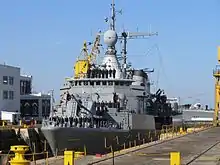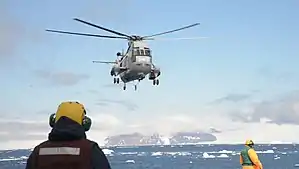Sea Fleet Command (Argentina)
The Sea Fleet Command (Spanish: Comando de la Flota de Mar; COFM) is one of the commands in the Argentine Navy, headquartered at Puerto Belgrano Naval Base (BNPB).
| Sea Fleet Command | |
|---|---|
| Comando de la Flota de Mar | |
 ARA La Argentina (D-11) Almirante Brown-class destroyer in Puerto Belgrano Naval Base. | |
| Country | Argentina |
| Branch | Argentine Navy |
| Role | Naval warfare |
| Size | 20 ships |
| Part of | Navy Training and Enlistment Command |
| Garrison/HQ | Puerto Belgrano Naval Base |
| Nickname(s) | COFM, FLOMAR |
| Engagements | Falklands War Operativo Alfil |
| Commanders | |
| Commander of the Sea Fleet | Ship-of-the-line captain Julio Horacio Guardia[1] |
| Insignia | |
| Identification symbol |  |
Mission
The Sea Fleet is in charge of the integrated naval training, counts on marines unit (Spanish: Fuerza de la Infantería de Marina de la Flota de Mar) and a naval aviation unit (Spanish: Grupo Aéreo Embarcado) attached.
Current composition
Destroyers Division
- Mission: Surface warfare, submarine warfare, anti-missile and electronic warfare[2]
- Ships:[3]
- ARA Almirante Brown - Almirante Brown-class destroyer
- ARA La Argentina - Almirante Brown-class destroyer
- ARA Heroína - Almirante Brown-class destroyer (inactive)
- ARA Sarandí - Almirante Brown-class destroyer
Frigates & Corvettes Division
- Mission: Sea control, surface warfare, submarine warfare, anti-missile and electronic warfare[2]
- Ships:[3]
- ARA Espora - Espora-class corvette
- ARA Rosales - Espora-class corvette
- ARA Spiro - Espora-class corvette
- ARA Parker - Espora-class corvette
- ARA Robinson - Espora-class corvette
- ARA Gómez Roca - Espora-class corvette
- ARA Drummond (P-31) - Drummond-class corvette (in reserve)
- ARA Guerrico (P-32) - Drummond-class corvette (in reserve)
- ARA Granville (P-33) - Drummond-class corvette (active)
Naval Amphibious and Logistic Command
- Mission: Planning and execution of amphibious warfare, anti-aircraft warfare and logistical support of the fleet[2]
- Ships:[3]
- ARA Hercules multi-purpose transport ship converted from a Type 42 destroyer
- ARA Patagonia Durance-class tanker
- ARA Canal Beagle Costa Sur-class cargo ship
- ARA Bahía San Blas Costa Sur-class amphibious cargo ship
- ARA Cabo de Hornos Costa Sur-class cargo ship
- ARA Punta Alta multipurpose auxiliary ship
- ARA Teniente Olivieri Marsea-class aviso
- ARA Estrecho de San Carlos Neftegaz-class aviso
- ARA Bahía Agradable Neftegaz-class aviso
- ARA Islas Malvinas Neftegaz-class aviso
Embarked Air Group

- 2nd Naval Air Helicopters Squadron Sikorsky S-61D-4 Sea King helicopter on Almirante Irízar icebreaker.
- 3rd Naval Air Helicopters Squadron Eurocopter AS555 SN Fennec 2 helicopter on MEKO-360 and MEKO-140 ships.
Falklands War

Between April and June 1982 Argentina entered into conflict in the Falklands War with the United Kingdom. An amphibious landing force, under the command of Admiral Walter Allara, occupied the Islands within a few hours on the morning of April 2. The flagship was the destroyer ARA Santísima Trinidad (D-2), which led to the naval commandos that forced the surrender of the forces of the Royal Marines and the British Governor Rex Hunt. The landing ship ARA Cabo San Antonio disembarked the LVTP-7 armored vehicles that consolidated the occupation.[4]
On May 2, the Brooklyn-class cruiser ARA General Belgrano (C-4) was torpedoed and sunk by the nuclear submarine HMS Conqueror (S48), with two MK8 torpedoes, after returning from an unsuccessful incursion against the British fleet. One of its escorts, the destroyer ARA Bouchard (D-26) received out of lethal distance, the explosion of the third torpedo of the salvo launched by the Conqueror, suffering minor damage.[4]
The submarine ARA Santa Fe (S-21), which had been attacked on April 25 with anti-ship missiles from helicopters, had to be abandoned semi-sunken in the South Georgia Islands. Finally it went down in deep water when it was tried to change it of dock.[4]
It was also attacked by helicopters the aviso ARA Sobral (A-9), which returned to the continent with the bridge destroyed and several casualties, including its Commander.[4]
In operations in the waters of the Falkland Islands, the transport ships ARA Isla de los Estados (B-8) and the Merchant Río Carcarañá were lost, both destroyed by air and naval forces of the British Task Force, suffering the first numerous ship while the ARA Bahia Buen Suceso (B-6) transport, which was part of the Naval Transportation Command along with the Isla de los Estados, ran aground in the south of the San Carlos strait, in front of Fox Bay, and it must have been abandoned by its crew. It was sunk by the British in deep water after the war. The three ships had both civilian and military personnel among their crew.[4]
The coastal vessels also fulfilled an outstanding logistic work. The ARA Monsunen and ARA Forrest, both captured from the British on April 2, which was joined by the small schooner Penelope on May 7, when it was spotted at the Aguila Island station at Buen Suceso Bay. The Forrest faced with light arms fire and caused damage to a Sea Lynx helicopter belonging to the frigate HMS Alacrity on May Day, north of Puerto Argentino, when the aircraft ruled the naval fire of three British units, while the Monsunen, the 23 of the same month, survived with minor damage an unequal combat with the frigates HMS Brilliant and HMS Yarmouth, both supported by a helicopter that transported special forces to capture it in the vicinity of Cove Foca, west of the island of Boungaville.[4]
Despite the enemy's intense air-naval harassment, all transport missions executed by these smaller units ended successfully. The last of these was carried out by ARA Penélope, between Bahía Fox and Puerto Argentino. The small ship embarked fuel on May 26, the day in which sailed for the capital of the Islands after evading, with minor damage, the naval bombing to which the port facilities were subjected by the frigate HMS Plymouth. The schooner arrived at destiny the day 2 of June, when the Naval Commando gave it already by lost.[4]
No less important was the task of the Yehuin, a boat 50 meters long, however their tasks were essential during the Falklands War. The Yehuin was a merchant that during the conflict was used by the Argentine Navy to supply and make transfers of equipment and troops between the two islands. Even though the British Navy had arranged a total blockade in the area, with the lights off, without radio communications and in the darkness of the south, the Yehuin managed to violate the measure and carry cargo and even wounded.[4]
Between the 16th and the 18th of May, the destroyer ARA Bouchard (D-26), who was with his twin the ARA Piedrabuena (D-29), making patrolled radar in front of Rio Grande (seat of the Naval Aviation and Infantry), to prevent enemy incursions, contributed to the detection of British Command ships, opening fire on them with their 127 mm guns and then detecting a Sea King helicopter, which was abandoned and set on fire in Chilean territory, from where the SAS Commandos were evacuated from the RAF. The Operation Mikado, developed against the Argentine continental territory, discovered after the war, whose mission was to eliminate the pilots of Super Etendart and destroy the aircraft, to annul the power of the Exocet AM-39 missiles, was thus disbanded. This action was the only one of naval fire in conventional combat, effective and of greater caliber, of the Fleet of Sea.[4]
References
- "Asumió el nuevo Comandante de la Flota de Mar". Gaceta Marinera (in Spanish). Puerto Belgrano. 16 March 2018. Retrieved 3 June 2018.
- Libro Blanco de la Defensa 2015 (PDF) (in Spanish) (1st ed.). Ministry of Defense (Argentina). 2015. pp. 83–84. ISBN 978-987-3689-22-2. Retrieved 6 June 2018.
- "Infografía Zona Militar – El Poder Naval Argentino". Zona Militar (in Spanish). 4 January 2018. Retrieved 6 June 2018.
- "La Armada Argentina en la Guerra de las Malvinas". Histarmar (in Spanish). Retrieved 5 June 2018.
